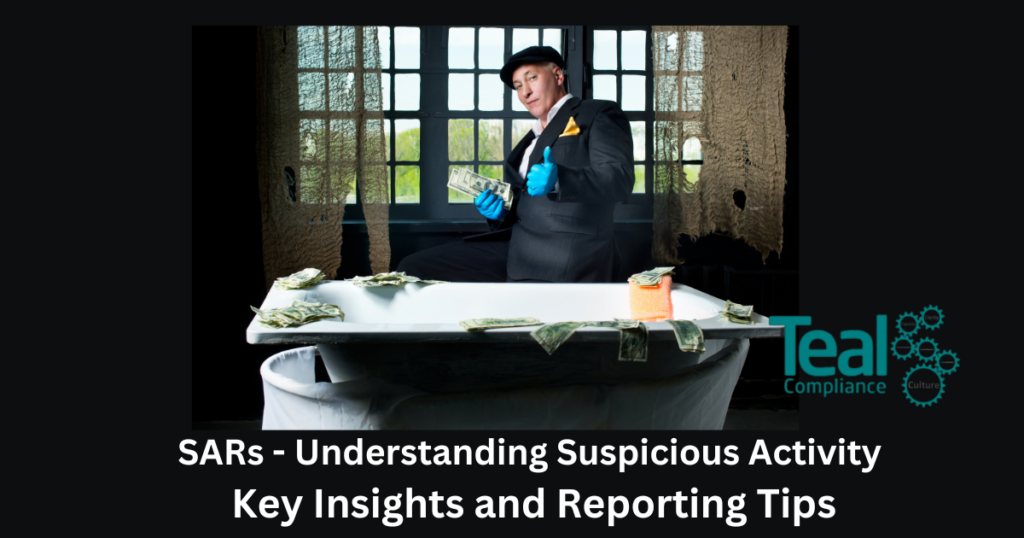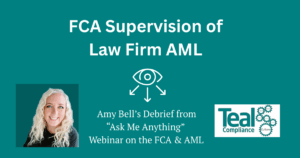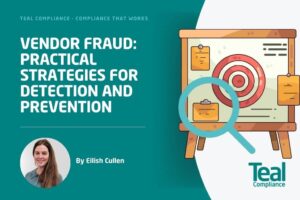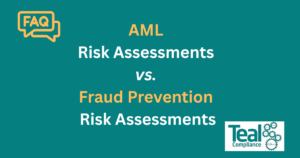Teal Compliance explains the signs of suspicious activity in law firm compliance and risk management.
Before I kick off this blog, I’m going to remind you (or explain to you if you are new to the role of an MLRO or COLP) what suspicious activity actually means when it comes to law firm compliance and risk management.
In the context of anti-money laundering (AML) compliance, “suspicious activity” refers to behaviour, transactions, or patterns of conduct that give rise to a suspicion that money laundering or other criminal activity might be taking place.
Persons working in the regulated sector are required under part 7 of the Proceeds of Crime Act 2002 (POCA) and the Terrorism Act 2000, taking into account relevant guidance provided by your regulator, for example the SRA and the Law Society of England and Wales.
If you hold a client account, carry out work in trust and company formation, or offer conveyancing as a legal service, you are more likely to be targeted by financial criminals. Our ASK TEAL service is extremely helpful and supportive for defining suspicious activity, understanding reasonable grounds, inappropriate use, responsibilities of the MLRO / MLCO (depending on size of firm), and the process around reporting economic crime.
To get an idea of the amount of reports submitted, the UK Financial Intelligence Unit (UKFIU) receives over 460,000 SARs per year and stores them in a secure central database.
Before I crack on with more guidance and examples of suspicious activity, here’s a reminder of acronym meanings:
- SOW – source of wealth
- SOF – source of funds
- SAR – suspicious activity report
- MLRO – money laundering reporting officer
- MLCO – money laundering compliance officer
- AML – anti-money laundering
- CDD – customer due diligence
- DAML – defence against money laundering
This blog is predominantly for the legal profession and we’re kicking it off with Section 12 of The Money Laundering, Terrorist Financing and Transfer of Funds (Information on the Payer) Regulations 2017 (Regulations), Section 12 definition.
AML Guide: Independent legal professionals/trust/company service providers
So, when we’re talking about ‘independent legal professionals’ in these regulations, what we’re really referring to is a firm or a solo lawyer, you know, someone who’s running their own show, providing legal or notarial services to other people. But, and this is important, it’s specifically when they’re involved in financial or property deals.
Think things like:
- the buying and selling of real estate and property or business entities;
- Management of client money, securities or assets;
- the opening or management of bank, savings or securities accounts;
- anything to do with setting up, running, or managing a company, when money’s involved; or
- the creation, operation or management of trusts, companies, foundations or similar structures.
When you ever read someone that ‘participates’ in a transaction for these rules, what we’re talking about is if they’re helping out with the planning or actually making the transaction happen. Essentially, if they’re acting for the client in some way during the whole thing. It’s about being involved, not just watching from the sidelines.
And then, when we get to ‘trust or company service provider’ that’s a firm who’s running a business and offering these specific services to clients. Now, the key here is, it’s only when we’re actually providing these services that we fall under that definition. So, basically, if I’m providing these services:
- forming a firm (The SRA’s definition – forming any entity that, whether or not a legal person, is not an individual and includes a body corporate and a partnership or other unincorporated association)
- acting, or arranging for another person to act
- as a director or secretary of a company
- as a partner of a partnership; or
- in a similar capacity in relation to other legal persons;
- providing a registered office, business address, correspondence or administrative address or other related services for a company, partnership or any other legal person or legal arrangement;
- acting, or arranging for another person to act,
- as a trustee of an express trust or similar legal arrangement;
- or a nominee shareholder for a person other than a company whose securities are listed on a regulated market.
Here’s Section 12’s specifics from source READ HERE.
What is the Definition of Suspicious Activity?
So, what exactly counts as ‘suspicion’ in our line of work?
Well, it’s a lower hurdle than you might think. In the case of R v Da Silva the present standard is set. Lord Justice Longmore said,
“So, probably, ‘knowing’ will not arise and what will arise instead is ‘suspecting’, which is a very different state of mind to knowing. To suspect something, you have a state of mind that is well short of knowing that the matter that you suspect is true. It is an ordinary English word. Members of the jury, if the Crown can show that the defendant said to herself, ‘I suspect that this money is the proceeds of criminal conduct, but it may be, on the other hand, that it is not’, that would fall within the definition of ‘suspicion’. The dictionary definition, which I direct you is relevant to the meaning of the word, is this. The dictionary definition of ‘suspicion’: ‘an act of suspecting, the imagining of something without evidence or on slender evidence, inkling, mistrust’. Therefore, any inkling or fleeting thought that the money being paid into her account 9950 might be the proceeds of criminal conduct will suffice for the offence against her to be proved.”
Essentially, if there’s a possibility, beyond just a far-fetched one, that something’s amiss, you’ve got a reportable suspicion. Of course, a simple ‘gut feeling’ isn’t enough, but if you’re thinking ‘there’s a chance this isn’t right,’ it’s time to take action.
I’m often asked about examples and how far back in the SOF you should be looking at suspicious activity work or actions. The answer is…it depends…because no two clients are the same and no two matters are the same. I’d start by some training on this to begin with, and thereafter have a clear protocol in your policies for firmwide use and follow with proactive controls. Better safe than sorry right?
Suspicious activity may include:
Unusual or inexplicable transactions: Let’s say you’re a conveyancer and your client has passed on admin and payments to a proxy third party. Why? Maybe the purchase price is much higher than current market value. Is your retainer set out £1,000 but they are insistent they’d like to be retained at £10,000? There are a variety of red flags to watch out for here.
Inconsistent behaviour: We would urge you to be on high alert for inconsistent purchaser behaviour in conveyancing or commercial entities. Are they changing key details, are they hard to get hold of, putting off replying to urgent requests? Time to investigate them further!
Deceptive and secretive clients: Got a client that seems evasive? Is the client avoiding questions? Is the client providing incomplete or false information? Why did the client choose your firm?
Exploitation of professional services: You will have been hiding under a rock if you don’t realise that financial criminals target us in the legal services to hide the origins of their illicit funds, i.e. dirty cash. Remember this case of a well paying and long standing corporate client who manipulated their instructing firm and chugged £4.1m through the client account for use of a banking account? The firm was fined £36k by the SRA. Legal Futures article can be read HERE.
A suspicion does not require certainty or concrete proof of money laundering. Instead, it arises when, based on the available information you have, a reasonable person concludes that there is something unusual warranting further investigation.
You’ll no doubt have read the latest cases for firms being fined for breaching AML conditions, like the firm where two partners were fined £50k for offering a banking facility to their wealthy client. In 2023 – 2024 alone, the SRA “submitted 23 SARs, performed 237 proactive inspections, and 258 desk-based reviews, and brought enforcement action against a combined total of 78 firms and individuals.”
This is Teal’s original blog, which has more information to delve into: “AML Definition of Suspicion”
Please note that failure to file a SAR after suspicion is raised is an offence under UK law. You can read the full Law Society guidance HERE.
Key Indicators of Suspicious Activity
The following are some classic examples of what to look out for in terms of red flags.
Unusual Transactions
- Large, unexpected deposits with no clear explanation.
- Multiple small transactions that together exceed a threshold.
- Use of complex legal structures (e.g., trusts, offshore companies) without clear rationale.
Client Behaviour
- Reluctance to provide identification or supporting documentation.
- Insistence on confidentiality without clear reason.
- Clients seeking to use cash for large transactions.
High-Risk Jurisdictions
- Funds originating from or being sent to high-risk jurisdictions (e.g., countries known for corruption or weak AML controls)
- Keep your “Black and grey” lists pinned to your desktop for continued updates.
Conveyancing and Real Estate
- Over or under valuation of property compared to market norms.
- Use of funds from unverified sources, particularly cash deposits.
Obligations for Law Firms
Under the AML regime, solicitors and law firms must:
- Conduct Customer Due Diligence (CDD): Verify the client’s identity and the source of funds.
- Monitor Transactions: Look for unusual patterns or behaviours.
- Report Suspicious Activity: File a Suspicious Activity Report (SAR) to the UK Financial Intelligence Unit (FIU) within the National Crime Agency (NCA) if suspicious activity is identified.
Scenarios of Suspicious Activity
Here are some examples that will give you some insights into what and how organised crime can work:
Scenario 1: High-Value Cash Deposit for a Property
A solicitor is instructed by a new client to assist in purchasing a property worth £1.5 million. The client insists on paying £1 million in cash and provides vague explanations for the source of funds. Despite requests for supporting documentation, the client refuses to provide details.
Red Flags: Large cash payment, lack of source-of-funds evidence, and unwillingness to cooperate.
Action: The solicitor would usually file an internal suspicious activity report to their MLRO and then it is the responsibility of the MLRO to decide whether a SAR needs to be made to the NCA.
Scenario 2: Use of Offshore Companies
A client establishes an offshore company and instructs a solicitor to assist with purchasing several properties. The company is registered in a jurisdiction with weak AML controls, and the client is vague about the ultimate beneficial owner (UBO).
Red Flags: Complex structures without legitimate purpose, high-risk jurisdiction, and lack of transparency regarding UBOs.
Action: The solicitor must conduct enhanced due diligence (EDD), request documentation to identify the UBO, and must speak to their MLRO, and then file a SAR if suspicions persist.
Scenario 3: Unusually Structured Payments
Corporate client instructs a law firm to hold funds in a client account as part of a commercial transaction. The funds are received in multiple instalments from unrelated third parties, and the client can’t provide a satisfactory explanation.
Red Flags: Multiple third-party payments, no legitimate business explanation.
Action: Conduct CDD on all parties involved, report to their MLRO, and refuse to proceed if concerns remain, and consider filing a SAR.
Scenario 4: Evasive Client Behaviour
A client seeks advice on setting up a trust but is reluctant to disclose the purpose or the source of the funds. The client requests frequent meetings but provides contradictory information about their income and assets.
Red Flags: Lack of transparency, contradictory information, and attempts to obscure the trust’s purpose.
Action: Ask further questions, verify the information provided, and if suspicions persist, file a SAR.
ALWAYS report suspicious activity to your MLRO come what may.
What triggers a suspicious activity report (SAR) in the UK?
Here’s the deal. There are these laws we have to follow, right? Part 7 of the Proceeds of Crime Act (POCA) and the Terrorism Act. Basically, if you’re working in a regulated field – and that’s us – you have to file a Suspicious Activity Report if you have a sniff that someone’s trying to launder money, evade tax or fund terrorism.
If you, as a law firm, suspects that a client’s SOW or SOF is suspicious, you have to:
- Conduct further inquiries to clarify the situation.
- Document all findings and decisions.
- Consider whether to file a Suspicious Activity Report (SAR).
Reporting Suspicious Activity (SAR)
The above triggers would mean then that you, as an MLRO, or compliance officer, overseeing compliance in your firm should report suspicions straight away to the NCA and SRA (if regulated by the SRA) as follows.
National Crime Agency (NCA):
Yes, as a law firm, you are legally required to report suspicious activity to the NCA via a SAR. The NCA has made this easy to do, as they have a secure SAR portal that you can submit a Suspicious Activity Report.
It shouldn’t surprise you that the SAR portal is SECURE.
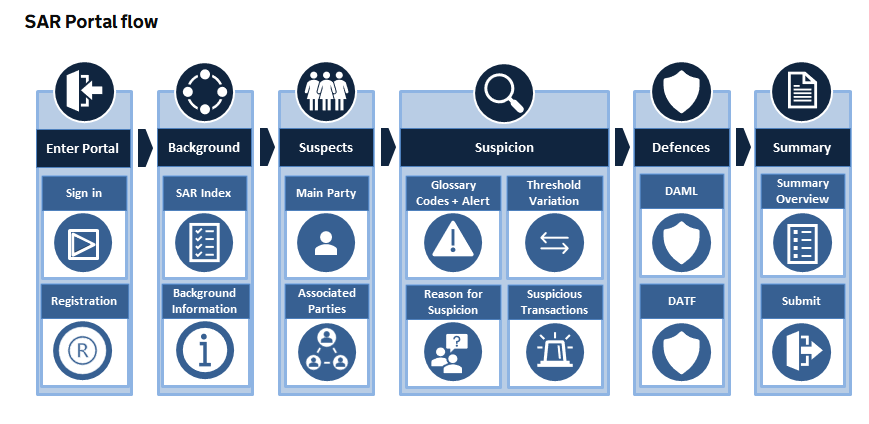
Solicitors Regulation Authority (SRA):
While a legal practice has to primarily report suspicious activity to the NCA, it also has obligations to the SRA. Doesn’t everything?!
If the suspicious activity involves a breach of SRA rules or raises concerns about the firm’s compliance, they must report this to the SRA.
Aligning to the SRA’s guidance, you’ve got to report all serious breaches of the money laundering regulations to them. Schedule 4 (12) of the regulations state that supervisors have to collect all information regarding the number of contraventions of these Regulations committed by supervised persons.
A reminder of what constitutes as a Serious Beach
- serious or persistent compliance failures involving safeguards designed to prevent money laundering
- clear risks of money-laundering activity taking place, or
- where there has been potential loss or harm to businesses or individuals.
ASK TEAL is the perfect support solution and service for you, where our compliance consultants and associates are on hand to guide you through your query. Please find out more HERE.
The SRA has its ETHICS HELPLINE to help if unsure: 0370 606 2577
Amy's Reminders and Key Takeaways
Further to the Law Society Risk & Compliance Conference 2025, there is a clear requirement for law firms to conduct better and more robust AML protocols. Don’t rely on a template and not tailor it to your clients and areas of work.
Always conduct thorough CDD and escalate to EDD where necessary.
Please be vigilant about client behaviour, source of funds, and high-risk jurisdictions.
Report suspicions promptly through a SAR, even if it means delaying or refusing a transaction. It’s just not worth the risk.
If there’s one thing I’ve learned in my years working with law and AML, it’s this: meticulous record-keeping is your ultimate defence when demonstrating compliance.
Suspicious Activity Resources Reminder
- Proceeds of Crime Act 2002: The primary legislation governing SARs together with the Terrorism Act 2000 (TACT).
- Money Laundering Regulations 2017: Sets out AML obligations for law firms. These regs were amended with:
- the Money Laundering and Terrorist Financing (Amendment) Regulations 2019 which came into force on 10 January 2020. This implemented broad changes to the regulations.
- the Money Laundering and Terrorist Financing (Amendment) (EU Exit) Regulations 2020 made narrow changes mainly to the requirements around trust registration.
When we draft Firm Wide Risk Assessments for clients we also refer to the 2023 amendments which you can read HERE. This amendment was made so that domestic PEPs are treated as lower risk than overseas PEPs, although to be clear, EDD does need to be applied in both instances.
- SRA Anti-Money Laundering Guidance: Provides detailed guidance on AML compliance.
- NCA SAR Portal: The online platform for filing SARs.
Thanks for reading, and please get in touch with any questions, you know I’m always happy to help.
Amy (with a big dollop of help from Rhiannon!)

